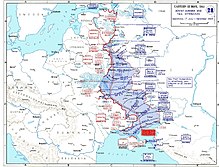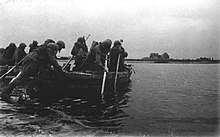Battle of the Dnieper
Battle of the Dnepr
Part of: World War II, Eastern Front
Significant military operations during the German-Soviet War
1941: Białystok-Minsk - Dubno-Luzk-Rivne - Smolensk - Uman - Kiev - Odessa - Leningrad Blockade - Vyazma-Bryansk - Kharkov - Rostov - Moscow - Tula1942
: Rzhev - Kharkov - Enterprise Blue - Enterprise Brunswick - Enterprise Edelweiss - Stalingrad - Operation Mars1943
: Voronezh-Kharkov - Operation Iskra - North Caucasus - Kharkov - Enterprise Citadel - Oryol - Donets-Mius - Donbass - Belgorod-Kharkov - Smolensk - Dnepr1944
: Dnepr-Carpathians - Leningrad-Novgorod - Crimea - Vyborg-Petrosavodsk - Operation Bagration - Lviv-Sandomierz - Yassy-Kishinev - Belgrade - Petsamo-Kirkenes - Baltic States - Carpathians - Hungary1945
: Courland - Vistula-Oder - East Prussia - Western Carpathians - Lower Silesia - Eastern Pomerania - Lake Balaton - Upper Silesia - Vienna - Oder - Berlin - Prague.
The Battle of the Dnieper (Russian Битва за Днепр) took place between Wehrmacht and Red Army units in Germany's 1941-1945 war against the Soviet Union from 26 August to 20 December 1943, forming the continuation of the Soviet summer offensive after the failure of Unternehmen Zitadelle, the last major German offensive in the East. The Battle of the Dnieper represented one of the rare examples of crossing a major river in the face of strong enemy opposition. The month-long operations culminated on November 6, 1943, with the Soviet liberation of Kiev.
Initial Situation
After the looming defeat in the Battle of Kursk (Unternehmen Zitadelle) in mid-July and the subsequent counter-offensives by the Red Army, the High Command of the Wehrmacht planned to build up a strong defensive line from the Baltic Sea to the Black Sea. In front of the two northern army groups, this "Eastern Wall" propagated by Hitler was to run roughly along the Narva-Pskov-Vitebsk-Gomel line to the Dnieper in the Kiev area and halt the further advance of the Soviet Western Front.
After Kharkov was liberated by the Red Army on 23 August 1943, three Soviet fronts opened another offensive. The 4th Panzer Army and the 8th Army formed the northern wing of Army Group South, which was attacked during the Chernigov-Poltava operation. Army Group South, under Field Marshal Erich von Manstein, was designed to stop the Soviet advance to the Dnieper River. His army group numbered 1.2 million soldiers, 12,600 guns, 2,100 tanks and 2,100 aircraft. It was opposed by five Soviet fronts (Central Front under Rokossovsky, Voronezh Front under Vatutin, Steppe Front under Konev, Southwest Front under Malinovsky, Southern Front under Tolbuchin) with a total strength of 2.6 million soldiers, 51,200 guns, 2,400 tanks and 2,850 aircraft.

Eastern Front 17 July to 1 December 1943
First phase
Operations in the Donets Basin (16 August to 22 September)
→ Main article: Donets Basin Operation
On 16 August, the Soviet Southern and Southwestern Fronts attacked the German 6th Army and 1st Panzer Army. The two German armies formed the southern wing of Army Group South. By the time preparations were completed, the two Soviet fronts had about 1 million troops, 21,000 guns and grenade launchers, and 1257 tanks at their disposal. The initial attacks against the 1st Panzer Army did not achieve much success. The Southern Front, attacking a little later, achieved a breakthrough in the 6th Army area near Kuibyshevo. Through the gap at Kuibyshevo, Soviet units in the rear of the German formations penetrated to the Sea of Azov and were able to briefly cut off the German XXIX Army Corps. After heavy fighting, however, the German units were able to break free from the encirclement and withdraw. It was noticeable among the German units that several armored divisions had been withdrawn after successfully repelling the Mius offensive. This was not least connected with the heavy fighting in Italy. The 6th Army had only a few operational tanks left - in contrast to the Soviet units, which were supported by 800 tanks. Even the supply of some armored units could not stabilize the situation of the German troops. General von Manstein authorized the 6th Army to withdraw and take up new positions near Donetsk (then Stalino). But even these positions fell within a few days. For the 1st Panzer Army, operating more to the north, this had negative consequences; it now had to fall back as well. The Soviet units subsequently pushed forward with force and pushed the Wehrmacht towards the Dnepr. Further advances by the Red Army tore a new gap between the two German armies, through which rapid units later advanced further into the depths. As on the other front sections of the Army Group, it became apparent that the German soldiers were exhausted and the Red Army was difficult to stop. Nevertheless, the Red Army had lost 273,522 soldiers and 886 tanks or assault guns in these attacks.
Chernigov-Poltava operation (26 August to 30 September)
The Central Front under Army General Rokossovsky attacked on 26 August at the junction with Army Group Center, while Colonel General Koniev's Steppe Front attacked the 8th Army (formerly Army Division Kempf) further south. The German 4th Panzer Army was attacked by the Voronezh Front. The three Soviet fronts had 1,581,300 men, facing about 350,000 soldiers on the German side. The latter, however, were in a strong defensive position. The Soviet 60th Army (General Chernyakhovsky) managed to break into the German defensive lines south of Sevsk with difficulty within the next few days. Only after the main forces of the front, the 9th Panzer Corps and the 13th Army (General Pukhov), had been moved there under strict secrecy did they succeed in extending this breach to 100 kilometers wide and 60 kilometers deep by August 31, forcing the German 2nd Army (Colonel General Weiss) to retreat.
In the course of this operation, the Red Army captured a number of major cities, such as Sumy (September 2), Chernigov (September 21), and Poltava (September 23), reached the Dnieper River, and established a series of bridgeheads on its left bank. As a result of the two Soviet operations, the Wehrmacht began planning a full retreat behind the Dnieper. The Red Army bought its victory with extremely high losses: during the Chernigov-Poltava operation it lost 427,952 men.
German retreat behind the Dnepr
On September 8, Hitler appeared at the headquarters of Field Marshal von Manstein in Zaporozhye, at the meeting of the situation were also present Field Marshal von Kleist, the commander of Army Group A and Colonel General Ruoff. To obtain reserves was finally allowed the abandonment of the Kuban bridgehead by the 17th Army. In addition, the withdrawal of the 6th Army to the Panther position was authorized. Hitler, however, insisted on holding an eastern bridgehead at Nikopol and Zaporozhye in order to be able to recapture the Donets Basin, which was important for the war economy, from this position.
On September 15, Army Group South finally began the necessary retreat to the western bank of the Dnieper. Within a very short time, 15 general commands with 63 divisions and all their equipment had to be moved essentially on only six bridges to the other bank of the Dnieper and fanned out again on a new front 700 kilometers wide. In addition to about 1 million soldiers, about 200,000 wounded and as many civilians were passed through, plus 153,000 horses and 270,000 sheep. The 4th Panzer Army, deployed on the left wing, with the VII and XIII Army Corps, fell back through Kiev to the left bank under enemy pressure. The 8th Army completed its retreat across the bridges at Cherkassy and Kremenchug, and the XXIV Panzer Corps deployed on the left put its formations across at Kanev. The mass of the 1st Panzer Army, retreating behind the great Dnieper bend, succeeded in crossing to the western bank in time at Zaporozhye and Dnepropetrovsk. The pursuing troops of the Southwest Front under General Malinowski reached the Dnieper on September 22. Soviet vanguards were already threatening Dnepropetrovsk, but were pushed back in time by a German counterattack. Transition points for the 6th Army were assigned at Kherson and Nikopol. The German front was restored and temporary stabilization occurred on the southern wing of Army Group South. In the south, the 6th Army had instructions to hold another eastern bridgehead with the IV Army Corps at Nikopol, the XXIX and XXXXIV Army Corps were to try to hold the so-called "Wotan" position in the area east of Melitopol to the Sea of Azov.

A unit of the Red Army crossing a river
Soldiers of the Greater Germany Division near Poltava (Sept. 1943)
Search within the encyclopedia